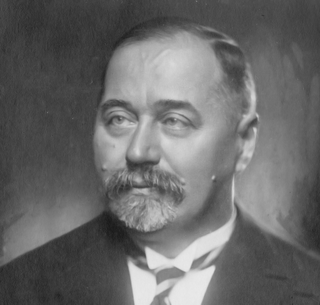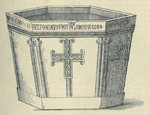
The Croatian Peasant Party is an agrarian political party in Croatia founded on 22 December 1904 by Antun and Stjepan Radić as Croatian Peoples' Peasant Party (HPSS). The Brothers Radić believed that the realization of Croatian statehood was possible within Austria-Hungary, but that it had to be reformed as a Monarchy divided into three equal parts – Austria, Hungary, Croatia. After the creation of Kingdom of Yugoslavia in 1918, Party requested for the Croatian part of the Kingdom to be based on self-determination. This brought them great public support which culminated in 1920 parliamentary election when HPSS won all 58 seats assigned to Croatia.

The State of Slovenes, Croats and Serbs was a political entity that was constituted in October 1918, at the end of World War I, by Slovenes, Croats and Serbs (Prečani) residing in what were the southernmost parts of the Austro-Hungarian Empire. Although internationally unrecognised, this was the first incarnation of a Yugoslav state founded on the Pan-Slavic ideology. Thirty-three days after it was proclaimed, the state joined the Kingdom of Serbia and the Kingdom of Montenegro to form the Kingdom of Serbs, Croats and Slovenes.
Clerical fascism is an ideology that combines the political and economic doctrines of fascism with clericalism. The term has been used to describe organizations and movements that combine religious elements with fascism, receive support from religious organizations which espouse sympathy for fascism, or fascist regimes in which clergy play a leading role.

Stjepan Radić was a Croat politician and founder of the Croatian People's Peasant Party (HPSS), active in Austria-Hungary and the Kingdom of Serbs, Croats and Slovenes.

Catholic clergy involvement with the Ustaše covers the role of the Croatian Catholic Church in the Independent State of Croatia (NDH), a Nazi puppet state created on the territory of Axis-occupied Yugoslavia in 1941.

Aloysius Viktor Stepinac was a senior-ranking Yugoslav Croat prelate of the Catholic Church. A cardinal, Stepinac served as Archbishop of Zagreb from 1937 until his death, a period which included the fascist rule of the Ustaše over the Axis puppet state the Independent State of Croatia from 1941 to 1945 during World War II. He was tried by the communist Yugoslav government after the war and convicted of treason and collaboration with the Ustaše regime. The trial was depicted in the West as a typical communist "show trial", and was described by The New York Times as biased against the Archbishop. However, Professor John Van Antwerp Fine Jr. is of the opinion that the trial was "carried out with proper legal procedure". In a verdict that polarized public opinion both in Yugoslavia and beyond, the Yugoslav authorities found him guilty on the charge of high treason, as well as complicity in the forced conversions of Orthodox Serbs to Catholicism. Stepinac advised individual priests to admit Orthodox believers to the Catholic Church if their lives were in danger, such that this conversion had no validity, allowing them to return to their faith once the danger passed. He was sentenced to 16 years in prison, but served only five at Lepoglava before being transferred to house arrest with his movements confined to his home parish of Krašić.

The Kingdom of Croatia-Slavonia was a nominally autonomous kingdom and constitutionally defined separate political nation within the Austro-Hungarian Empire. It was created in 1868 by merging the kingdoms of Croatia and Slavonia following the Croatian–Hungarian Settlement of 1868. It was associated with the Kingdom of Hungary within the dual Austro-Hungarian state, being within the Lands of the Crown of St. Stephen, also known as Transleithania. While Croatia had been granted a wide internal autonomy with "national features", in reality, Croatian control over key issues such as tax and military issues was minimal and hampered by Hungary. It was internally officially referred to as the Triune Kingdom of Croatia, Slavonia and Dalmatia, also simply known as the Triune Kingdom, and had claims on Dalmatia, which was administrated separately by the Austrian Cisleithania. The city of Rijeka, following a disputed section in the 1868 Settlement known as the Rijeka Addendum, became a corpus separatum and was legally owned by Hungary, but administrated by both Croatia and Hungary.

The Croatian Orthodox Church was a religious body created during World War II by the Fascist Ustaše regime in the Independent State of Croatia (NDH). It was created in order to assimilate the remaining Serb minority and also to unite other Orthodox communities into a state-based Greek Orthodox Church.

The Magnum Crimen is a book about clericalism in Croatia from the end of 19th century until the end of the Second World War. The book, whose full title is Magnum crimen – pola vijeka klerikalizma u Hrvatskoj, was written by a former Catholic priest and a professor and historian at Belgrade University, Viktor Novak (1889–1977). The book was first published in Zagreb in 1948.
Ljubomir Maraković was a Croatian literary critic and historian, and one of the leaders of the Croatian Catholic movement.

Anton Mahnič, also spelled Antun Mahnić in Croatian orthography, was a Croatian-Slovenian prelate of the Catholic Church and a philosopher who established and led the Croatian Catholic Movement. Mahnič served as the bishop of Krk from 1897 to his death in 1920.

The Holocaust in the Independent State of Croatia involved the genocide primarily of Jews, and also the genocide of Serbs and Romani (Porajmos), within the Independent State of Croatia, a fascist puppet state which existed during World War II, was led by the Ustaše regime, and ruled an occupied area of Yugoslavia which included most of the territory of modern-day Croatia, the whole of modern-day Bosnia and Herzegovina and the eastern part of Syrmia (Serbia). Of the 39,000 Jews who lived in the NDH in 1941, the United States Holocaust Memorial Museum states that more than 30,000 were murdered. Of these, 6,200 were shipped to Nazi Germany and the rest of them were murdered in the NDH, the vast majority in Ustaše-run concentration camps, such as Jasenovac. The Ustaše were the only quisling forces in Europe who operated their own extermination camps for the purpose of murdering Jews and members of other ethnic groups.
Spremnost was a weekly newsmagazine of the Ustaše movement with articles about many topics like politics, war, economy and culture. It was published in Zagreb from early 1942 to the collapse of the Independent State of Croatia in May 1945. Its publication was restarted in 1957 in Sydney by Fabijan Lovoković, a former Ustaše Youth member who had fled to Australia in 1950. Publication of the magazine ceased in 2007.
Croatian Popular Party was a minor political party that acted as a political branch of the Croatian Catholic Movement and it existed between 1919 and 1929 in the Kingdom of Serbs, Croats and Slovenes. Until Stjepan Radić's assassination in National Assembly in Belgrade in 1928, the Croatian Catholic Movement was pro-Yugoslav, and after the assassination pro-Croatian within Yugoslavia. However, after the failure of the Yugoslav government to implement the concordate with the Holy See, the Croatian Catholic Movement became strictly pro-Croatian.

The May Declaration was a manifesto of political demands for unification of South Slav-inhabited territories within Austria-Hungary put forward to the Imperial Council in Vienna on 30 May 1917. It was authored by Anton Korošec, the leader of the Slovene People's Party. The document was signed by Korošec and thirty-two other council delegates representing South-Slavic lands within the Cisleithanian part of the dual monarchy – the Slovene Lands, the Dalmatia, Istria, and the Condominium of Bosnia and Herzegovina. The delegates who signed the declaration were known as the Yugoslav Club.

Svetozar Rittig was a Croatian Catholic priest, historian and politician.
The Zagreb Resolution was a political declaration on the need for political unification of the Croats, the Slovenes and the Serbs living in Austria-Hungary. It was adopted by representatives of opposition political parties in the Kingdom of Croatia-Slavonia presided by Ante Pavelić in a meeting held in Zagreb on 2–3 March 1918. The declaration relied on the right of self-determination and called for establishment of an independent democratic state respecting rights of individuals and historically established polities joining the political union. It also called for ensuring cultural and religious equality in such a union. The Zagreb Resolution established a preparatory committee tasked with establishment of the National Council of Slovenes, Croats and Serbs intended to implement the resolution. The National Council was established on 5 October in proceedings described by Pavelić as a continuation of the Zagreb conference that March.
Lav Mazzura was a politician and lawyer born in Zagreb. After studying law in Zagreb and Prague, he became one of leaders of the Croatian Progressive Youth. He was the editor of the Hrvatski pokret and the Hrvatska misao journals. In 1910–1913, Mazzura was a member of the Sabor of the Kingdom of Croatia-Slavonia as a member of the Croat-Serb Coalition led by Frano Supilo and Svetozar Pribičević. He was also a member of the joint Hungarian-Croatian Parliament in Budapest. In November–December 1918, Mazzura was in command of Zagreb-based forces assigned to the Commission for Public Order and Security of the National Council of Slovenes, Croats and Serbs – a body composed of political representatives of the South Slavs living in Austria-Hungary tasked with achieving independence of South Slavic lands from the empire. According to testimony of Slavko Kvaternik, Mazzura was involved in unsuccessful negotiations to peacefully resolve a standoff during the 1918 protest in Zagreb. In 1919, Mazzura was appointed to the post of the prosecutor for the city of Zagreb. He died in Zagreb in 1930.














